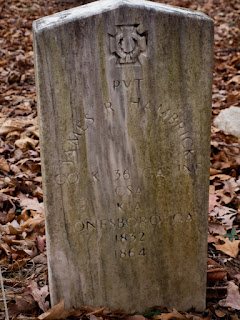"Flint Hill". There might have been flint there once upon a time. But a hill? Maybe. If you count the ditches on three sides as valleys.
They should have kept one of the other names. Old Harmony Cemetery or Old Norcross Methodist Cemetery would be far, far more believable.
I don't think I will ever cease being astounded to find these long abandoned cemeteries dating back to the earliest settlements by white people in these areas. In this case there is a marker for someone who died in 1831. The area only became an official part of the state in 1822! And that is just from someone with a carved stone marker. With all the dozens of obvious unmarked graves in the cemetery it could well be that the actual first burial was many years before that.
Here again is a cemetery in an industrial park. It is not exactly well marked though it is visible. If you bother to pause and look. I have to wonder how many people working in the adjacent and surrounding buildings even know it is there.
The property itself is considerably larger than it appears at first glance. In total it has to be between a half and about three-quarters of an acre. Or slightly more. If you look closely at the photo above you can see some of the original rough quarried granite fence posts that once comprised a fence surrounding the property. Originally there were 2 or 3 iron rods spanning the gap between posts. Only fragments of these remain. And part of the original gate hinge on one of the posts on the eastern border. It had to be quite impressive when first erected.
Sadly there are only about 32 identified graves. There are at least three additional graves that obviously had formal stone markers, but they have been damaged or stolen over the years. Two are but the marble bases for markers long missing. One is broken off, leaving only a date of death. Feb 24 1900. None of the individuals known to be interned here has that date of death.
Another mystery with little possibility of it being solved.
But that is, as Paul Harvey might put it, Page 1.
My searching located much more data!
First up was a link to some of the original cemetery records! I still have to cross check all these names against the memorials already logged in Find A Grave. But I have already found at least one person assigned to the wrong cemetery. Bad records, similar cemetery names, abandoned locations, and no headstones all conspire to create these errors.
In this case I found Albert Jake Warbington listed in the original cemetery records. The place was named Harmony Grove Cemetery or Old Harmony Grove at some point in addition to being Flint Hill United Methodist Church. Albert has (had - he has already been moved!) a Find A Grave memorial. In the wrong Harmony Grove Church Cemetery!
Finding him uncovered two other Warbington relatives with memorials in the same place. Naturally none have grave photos. Aside from being in the wrong place, they have no markers in Flint Hill either. Or if they ever did the markers are no longer visible if they survive.
All of these Warbingtons appear to descend from one Ellemander Warbington, Sr. resting here in Flint Hill. His grave leapt out to me because of the dual headstones!






No comments:
Post a Comment